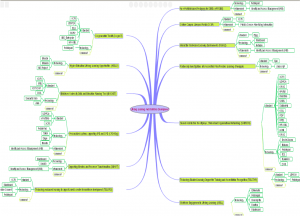It is true to say that we are lucky enough at times to be able to work on something that really is interesting, and that for me is true of the world of ‘service design’. I encountered this area as part of my work supporting the JISC Relationship Management programme, and can honestly say that it has genuinely piqued my interest. I only wish I had more time to learn more about it and ‘do’ service design in earnest.
It is a relatively new area, especially for education. Service design can help institutions to examine their processes from a student-centred point of view, and then by making improvements where required, it may be possible to:
• Improve student retention;
• Improve administrative processes;
• Provide a competitive edge;
• Reduce risks;
• Identify student needs, expectations and feelings.
Some people working on the projects in the programme have been so bitten by the bug that they report to have found their calling after many years, and are following the route to becoming specialists in it where possible.
I may sound evangelical about it all, but I do believe that to be successful, institutions would do well to at least nod to the basic concepts of the approach. Empathy is the key. For want of a better comparison, it is about customer service (and I know, many in education, particularly Higher Education, hate the concept of viewing students as customers.) But if we take the basic nuggets, then it boils down to putting yourself in the shoes of those that you are catering for, and it would be useful to adopt an ‘undercover boss’ approach and actually be in the thick of it and see it from the real perspective. We think we know what our students want but often we are wrong, or at best slightly off the mark. So many companies get customer service wrong, and we always remember those that get it right. And vote with our feet. It is the same for education.
I was pleased to discover that there are even jobs for ‘Service Designers’ but of course these are in large corporations, not the education sector. But maybe one day?
More about Service Design:
The CETIS Service Design briefing paper is averaging about 3500 downloads per year and is a useful starting point.
The CETIS wiki has a section on Service Design Resources. The latest addition to this is a Service Design toolkit website offering a toolkit as an introduction to the methodology of service design, in particular for the design of public services. Includes some useful (free) downloads to use when adopting the service design approach.
There is also a section on service design in the ‘Just Enough’ resource that we are developing which includes findings from the current projects and the synthesis from the last programme.
The wikipedia service design entry is also of use.



